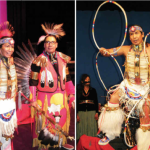
Lee Allen, Indian Country Today Media Network
Navajo Native Tony Redhouse doesn’t look his age, and for several decades he didn’t act it either. Now in his mid-50s, he was what is referred to as a “bad boy” in his formative years. In fact, because he was high all the time, he says he received his early education not in school, but on the street. “I was first incarcerated at the age of 14, put in a California mental hospital in a straightjacket, from an LSD overdose,” he says. “They called me Gas because of my habit of inhaling gasoline as a cheap high.”
Redhouse, who says there isn’t a drug he didn’t do, later got kicked out of his family’s home and ended up in foster care, where things just got worse because, he says, members of his adoptive family were also addicted to drugs.
What followed over the next 20 years and stretched from the Bay Area to England was a series of marriages (five), more trips to detox than he can remember (100-plus), medical problems (hepatitis C), a stint in prison (two years), and five alcohol-drug-related DUIs. “I had a habit of running into telephone poles and totaling vehicles,” he recalls. “I was in the dark for a long time. I wandered the streets unaware of where I was and not really caring. I ate out of Dumpsters. I committed crimes to get money for more drugs. I was suicidal and self-destructive.” Recognizing the inevitable end to the path he was on, family members intervened and had him committed to a mental hospital when he was 50.
And there he found both himself and a new path. “Although it had taken me half a century to reach that point, I came to my senses and decided to change my life.”
Once Redhouse decided to become a good guy, new vistas opened up for him as an inspirational speaker, a recording artist and a sound healer. He says those are all ways he can help others in need—addicts, domestic violence victims, grief and trauma survivors, and hospice members about to transition. “Because I had already walked the negative footsteps and knew their pitfalls, I began alternative teaching, sharing spirituality as a means of recovery influenced by Native American culture.”

He now lectures to capacity crowds across the Southwest and also teams up with such lecture-hall luminaries as Deepak Chopra and Dr. Oz. He speaks passionately of his years working with Native Ways women in recovery program at a Tucson, Arizona facility. According to that facility’s web page: “Therapy is designed to meet the unique needs of Native women and draws on their cultural strengths to promote healing and recovery” and quotes a Great Spirit Prayer—“Make me wise so that I may understand the things you have taught my people.… I seek strength not to be greater than my brother, but to fight my greatest enemy—myself.”
“The audience is 25 to 30 female addicts, some just out of prison or detox—a lot of them still strung out on meth and coke—and here I am, [at] the first phase of their recovery. I’m a visual artist in musical form—bells, bar chimes, wooden blocks, shakers, flutes, drums, a palette of sound equipment. The lights are turned off, candles are lit, and I start playing the flute and drum while humming a chant. These women don’t have an inkling about where we are headed, but every time the music begins, they put their heads down on the table and go into their own internal, calming space. The nurturing sound of the heartbeat drum brings security and takes them back to before their addiction, before being molested or beaten, returning back to the days before anything bad had happened.”
Redhouse says the simplicity of sound healing takes the mind to a place where it can begin to be clear enough to make healthy decisions. “If you think about indigenous cultures, there are three ancient forms of expression used in ceremony to express our emotions and dreams—voice, drum and flute. They speak louder than words and allow us to connect with the spiritual realm. When I use these sounds, they evoke thoughts, images, feelings that take people back to their beginning, back to the simple state, the sound of a heartbeat, a breath, the hum of a lullaby—back to a peaceful place, a sacred place, for us to start healing inside. We remove all the built-up complications and come back to the point where you can see clearly what your life is and what you want it to be.”
The healer’s philosophy, as he explained in a documentary co-produced by Chopra called Death Makes Life Possible, came from his hospice work. “I teach that if you are ready to die, then you are ready to live. Spending time with people who are transitioning, you see them settle old scores and make peace with people and situations so they can stop struggling and depart. We’d be wise to adopt that concept of clearing up unfinished business, closing the chapters in our lives that no longer serve us. If we can make peace to depart this world, we can also make conditions that will allow us to live passionately and completely.”
Continuing to help others helps him to continue helping himself. “I feel like I’m right in the center of my destiny, why I’m on this Earth, my life’s purpose, why I’ve gone through everything I’ve gone through so far that has shaped me, the ups and downs, the darkness. I’m doing things right now. I’m a tool in the hands of spirits, that’s all. I’ve become another instrument, blessed to have an opportunity to change other lives for the better.”
Read more at http://indiancountrytodaymedianetwork.com/2013/02/19/one-healers-story-started-healing-himself-through-drumming-and-singing-147754
